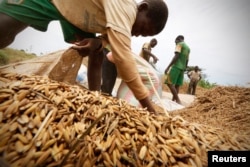Ivory Coast aims to become the rice bowl of West Africa as it ramps up production and processing of the regional staple food with an eye on beginning exports in 2018 and generating more than a million jobs, a government official said.
In the midst of an economic revival after years of political turmoil ended with a brief civil war in 2011, the country better known as the world's biggest cocoa producer is investing about $4 billion as part of a program to diversify its agricultural sector and create jobs.
French-speaking West Africa's largest economy is growing again after the decade-long political struggle between a rebel-held north and government-controlled south. It achieved growth of 9.8 percent in 2012, but unemployment among its 20 million people remains high, especially among the youug.
Currently a rice importer, Ivory Coast spent about 235 billion CFA francs ($455 million) on rice from Thailand, India, Pakistan and Vietnam last year, but Yacouba Dembele, director of the national office for rice development, is targeting self-sufficiency within two years.
Dembele told Reuters that 477 billion CFA francs will be invested in the 2012-16 period to develop the rice industry, with about 60 percent coming from the private sector.
"We want to be the granary of the [West African] sub-region and from 2018 we want to start to satisfy the sub-region's rice needs," Dembele said. "We have the potential."
The government has signed investment agreements with foreign companies including France's Louis Dreyfus Commodities , Algeria's Cevital, Export Trading Group of Singapore and Switzerland's Ameropa.
Under the programme, the government is organizing distribution of high-yield seeds to farmers and bankrolling the development of new production areas and irrigation systems.
In and around the western town of Gagnoa - one of the areas that has benefited from the program despite being better known as a cocoa-growing hub - dozens of new rice plots have appeared.
Multiple Harvests
"There were plots that were abandoned and which are now being used," farmer Mamadou Diaby said over the noise of the small rice mill he operates in the town. "We have abundant rainfall, which means that we can grow year-round. There are plots that are doing two or even three harvests a year."
Ivory Coast's rice production jumped to 980,000 tons in 2012, the first year of the development plan, against 550,000 tons in 2011. Last year production hit 1.2 million tons, with output projected to rise to 1.6 million this season.
Imports, meanwhile, fell to 830,000 tons last year, from 1.26 million tons in 2012.
"For the first time in 30 years we have reduced imports by around 35 percent compared with the previous year. It's a trend that will continue," Dembele said.
With average annual consumption of 70kg per head of population, Ivory Coast will need to reach production of two million tons before it becomes self-sufficient - a level that Dembele said should be achieved in 2016.
The government then plans to build up stocks to guard against international price fluctuation before starting to export to its regional neighbors two years later.
"We have a large deficit in terms of processing," Dembele said. "If you produce paddy, you must be capable of processing it. It's a very important element in the chain."
India is lending Ivory Coast 30 billion CFA francs to buy 30 processing units, each with annual capacity of 25,000 tons, and to build storage units.
The Ivory Coast government expects locally produced and processed rice to go on sale alongside imported rice by April.
Quite apart from the obvious savings on import costs, the creation of a thriving local rice industry - from production to milling and marketing - will have a significant knock-on effect for the economy.
"In the end, this project will generate nearly 1.5 million jobs, directly or indirectly," Dembele said.
(1 US dollar = 516.6500 CFA franc)

